Orton C., Tyers P., Vince A. Pottery in archaeology
Подождите немного. Документ загружается.


Cataloguing
57
Fig. 4.1. Life in the pot shed. Painting by Janis Mitchell, from
The hamster
history of Britain,
published by Thames and Hudson Ltd., © Thames and Hudson 1991
quartz grains adhering to the pot. Remember that the join being stuck will
stretch during drying unless the two sherds are secure. With small sherds you
can use gravity to ensure a good join but larger ones must be arranged in the
sand so that there is no stress upon the join. If you are sticking several sherds
together then plan ahead, otherwise you will find that you have stuck the
sherds in the wrong order and cannot insert the next one. You may need to
wash or brush the sherd edges again before sticking them.
Cataloguing
We assume that you have made some sort of preliminary record of the pottery
and have determined what parts of the collection will be subject to a fuller
study
(fig. 4.
i). There are no hard and fast rules as to what should be recorded
although for the benefit of other scholars there might be two minimum
requirements:
1) The presence of a type of pottery in the collection should be
recorded. Urban excavations often produce large quantities of
pottery redeposited in modern deposits or for which no archaeo-
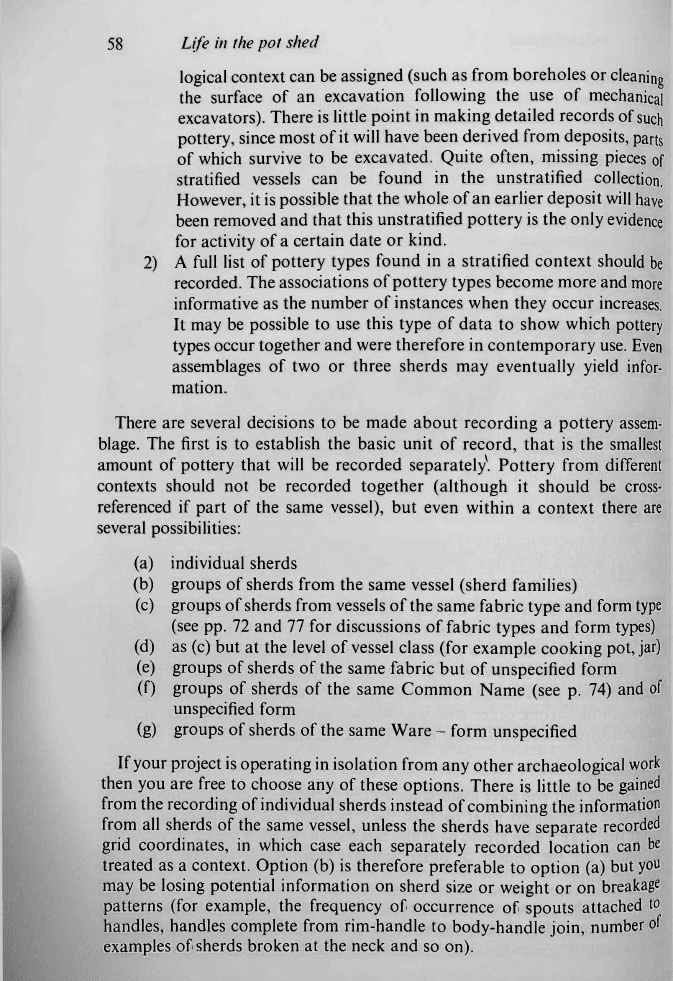
58 Life in the pot shed
logical context can be assigned (such as from boreholes or cleaning
the surface of an excavation following the use of mechanical
excavators). There is little point in making detailed records of such
pottery, since most of it will have been derived from deposits, parts
of which survive to be excavated. Quite often, missing pieces of
stratified vessels can be found in the unstratified collection.
However, it is possible that the whole of an earlier deposit will have
been removed and that this unstratified pottery is the only evidence
for activity of a certain date or kind.
2) A full list of pottery types found in a stratified context should be
recorded. The associations of pottery types become more and more
informative as the number of instances when they occur increases.
It may be possible to use this type of data to show which pottery
types occur together and were therefore in contemporary use. Even
assemblages of two or three sherds may eventually yield infor-
mation.
There are several decisions to be made about recording a pottery assem-
blage. The first is to establish the basic unit of record, that is the smallest
amount of pottery that will be recorded separately*. Pottery from different
contexts should not be recorded together (although it should be cross-
referenced if part of the same vessel), but even within a context there are
several possibilities:
(a) individual sherds
(b) groups of sherds from the same vessel (sherd families)
(c) groups of sherds from vessels of the same fabric type and form type
(see pp. 72 and 77 for discussions of fabric types and form types)
(d) as (c) but at the level of vessel class (for example cooking pot, jar)
(e) groups of sherds of the same fabric but of unspecified form
(f) groups of sherds of the same Common Name (see p. 74) and of
unspecified form
(g) groups of sherds of the same Ware - form unspecified
If your project is operating in isolation from any other archaeological work
then you are free to choose any of these options. There is little to be gained
from the recording of individual sherds instead of combining the information
from all sherds of the same vessel, unless the sherds have separate recorded
grid coordinates, in which case each separately recorded location can be
treated as a context. Option (b) is therefore preferable to option (a) but you
may be losing potential information on sherd size or weight or on breakage
patterns (for example, the frequency of occurrence of spouts attached to
handles, handles complete from rim-handle to body-handle join, number of
examples of sherds broken at the neck and so on).
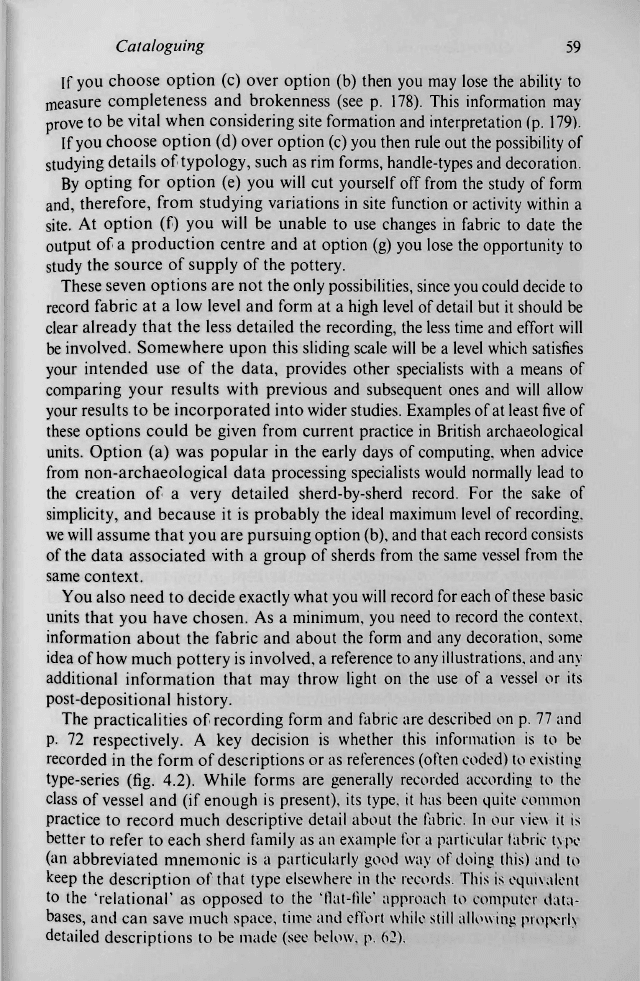
Cataloguing
59
If you choose option (c) over option (b) then you may lose the ability to
measure completeness and brokenness (see p. 178). This information may
prove to be vital when considering site formation and interpretation (p. 179).
If you choose option (d) over option (c) you then rule out the possibility of
studying details of typology, such as rim forms, handle-types and decoration.
By opting for option (e) you will cut yourself off from the study of form
and, therefore* from studying variations in site function or activity within a
site. At option (f) you will be unable to use changes in fabric to date the
output of a production centre and at option (g) you lose the opportunity to
study the source of supply of the pottery.
These seven options are not the only possibilities, since you could decide to
record fabric at a low level and form at a high level of detail but it should be
clear already that the less detailed the recording, the less time and effort will
be involved. Somewhere upon this sliding scale will be a level which satisfies
your intended use of the data, provides other specialists with a means of
comparing your results with previous and subsequent ones and will allow
your results to be incorporated into wider studies. Examples of at least five of
these options could be given from current practice in British archaeological
units. Option (a) was popular in the early days of computing, when advice
from non-archaeological data processing specialists would normally lead to
the creation of a very detailed sherd-by-sherd record. For the sake of
simplicity, and because it is probably the ideal maximum level of recording,
we will assume that you are pursuing option (b), and that each record consists
of the data associated with a group of sherds from the same vessel from the
same context.
You also need to decide exactly what you will record for each of these basic
units that you have chosen. As a minimum, you need to record the context,
information about the fabric and about the form and any decoration, some
idea of how much pottery is involved, a reference to any illustrations, and any
additional information that may throw light on the use of a vessel or its
post-depositional history.
The practicalities of recording form and fabric are described on p. 77 and
p. 72 respectively. A key decision is whether this information is to be
recorded in the form of descriptions or as references (often coded) to existing
type-series (fig. 4.2), While forms are generally recorded according to the
class of vessel and (if enough is present), its type, it has been quite common
practice to record much descriptive detail about the fabric. In our view it is
better to refer to each sherd family as an example for a particular fabric type
(an abbreviated mnemonic is a particularly good way of doing this) and to
keep the description of that type elsewhere in the records. This is equivalent
to the 'relational' as opposed to the 'flat-file' approach to computer data-
bases, and can save much space, time and effort while still allowing properly
detailed descriptions to be made (see below, p. 62).

60 Life in the pot shed
Fig. 4.2. Pottery cataloguing using pre-printed recording sheets, scales and a rim-chart
The recording of the amount of pottery present (the 'quantification
problem') has caused much controversy and is still not fully resolved. Our
views are set out in chapter 13 (p. 166), but it should be noted here that in
choosing a 'measure' of quantity it must be kept in mind that important
information, especially on site formation processes (p. 178) can be obtained
by comparing different measures.
Illustration is another topic that merits a separate chapter (p. 87), but it
is
important to note that it must be possible subsequently to identify unam-
biguously any vessels that have been drawn or photographed. Similarly,
sherds or vessels which have been removed from the collection for any reason
need to be separately recorded.
There are two ways in which this can be done. Firstly, you can place a note
in the box or bag from which the sherd has been removed. Museums quite
often have a system of placing pre-printed proxy cards in lieu of artefacts
which have been removed from their normal storage or display location. This
system works well with archaeological collections. The other place where
such information should be recorded is in your written record. It is quite
possible to be able to record information about a collection without any
means of identifying the individual sherds. To make an alteration to that
record, based on further study of the collection, you need to be able to link
particular records with sherds, or groups of sherds. The obvious way to
achieve this is to assign every sherd a unique number or code. Such a solution
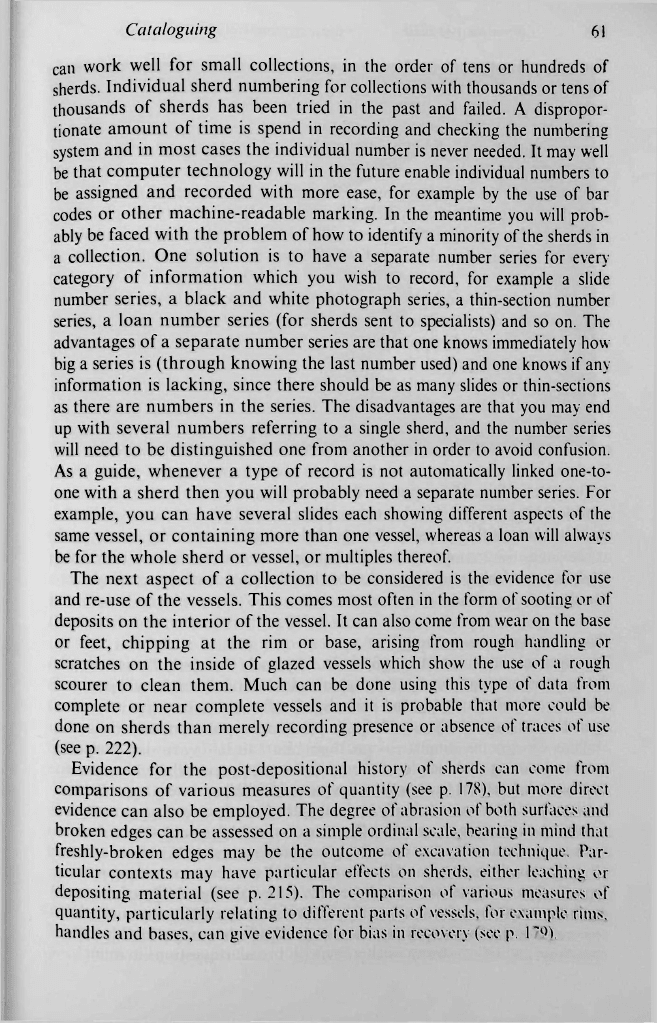
Cataloguing
61
can work well for small collections, in the order of tens or hundreds of
sherds. Individual sherd numbering for collections with thousands or tens of
thousands of sherds has been tried in the past and failed. A dispropor-
tionate amount of time is spend in recording and checking the numbering
system and in most cases the individual number is never needed. It may well
be that computer technology will in the future enable individual numbers to
be assigned and recorded with more ease, for example by the use of bar
codes or other machine-readable marking. In the meantime you will prob-
ably be faced with the problem of how to identify a minority of the sherds in
a collection. One solution is to have a separate number series for every
category of information which you wish to record, for example a slide
number series, a black and white photograph series, a thin-section number
series, a loan number series (for sherds sent to specialists) and so on. The
advantages of a separate number series are that one knows immediately how
big a series is (through knowing the last number used) and one knows if any
information is lacking, since there should be as many slides or thin-sections
as there are numbers in the series. The disadvantages are that you may end
up with several numbers referring to a single sherd, and the number series
will need to be distinguished one from another in order to avoid confusion.
As a guide, whenever a type of record is not automatically linked one-to-
one with a sherd then you will probably need a separate number series. For
example, you can have several slides each showing different aspects of the
same vessel, or containing more than one vessel, whereas a loan will always
be for the whole sherd or vessel, or multiples thereof.
The next aspect of a collection to be considered is the evidence for use
and re-use of the vessels. This comes most often in the form of sooting or of
deposits on the interior of the vessel. It can also come from wear on the base
or feet, chipping at the rim or base, arising from rough handling or
scratches on the inside of glazed vessels which show the use of a rough
scourer to clean them. Much can be done using this type of data from
complete or near complete vessels and it is probable that more could be
done on sherds than merely recording presence or absence of traces of use
(see p. 222).
Evidence for the post-depositional history of sherds can come from
comparisons of various measures of quantity (see p. 178), but more direct
evidence can also be employed. The degree of abrasion of both surfaces and
broken edges can be assessed on a simple ordinal scale, bearing in mind that
freshly-broken edges may be the outcome of excavation technique. Par-
ticular contexts may have particular effects on sherds, either leaching or
depositing material (see p. 215). The comparison of various measures of
quantity, particularly relating to different parts of vessels, for example rims,
handles and bases, can give evidence for bias in recovery (see p. 179),

62 Life in the pot shed
Computers in pottery research
The use of computers during the pottery processing cycle has already been
referred to several times above. The widespread availability of relatively ine^
pensive yet powerful computers and reasonably friendly software package
has impinged as much upon ceramics study as on many other aspects of
archaeology (see Richards and Ryan 1985 for a general account of the role
of
computers in archaeology and an explanation of technical terms). Many pro,
jects consider the role of computers from a very early state in their planning,
while for others computerisation seems an afterthought, and considerable
ingenuity may be required to shoe-horn poorly structured data into an unfor?
giving computer.
Two thoughts should be borne in mind when approaching the computeri-
sation of records of archaeological ceramics. Firstly, many of the basic
ground rules are equally applicable to the organisation and manipulation
of
paper records as they are to their computerised counterparts; and secondly,
it
is essential that the records of pottery can be co-ordinated both with the
records of other classes of artefact and structural or contextual data. When
presented with a pre-existing recording and computerisation system it is gen-
erally advisable to co-operate with it, unless there are very cogent arguments
for doing otherwise.
The practicalities of computerised recording systems for ceramics can be
considered in two parts: (i) what to computerise; and (ii) how to organise the
records. Many of the answers will be guided to a great extent by factors such
as the sophistication of the available equipment, your access to it and the
work flow, working conditions and so on, but there are some general rules-of-
thumb.
What to computerise
Some ceramics data could benefit from very early computerisation. Spot-
dates, incorporating lists of pottery types and dates of contexts, will prove
of
immense value both during and immediately after the excavation of a site.
Such data are particularly suitable for computer manipulation, and within
the
abilities of even the simplest of packages. For most day-to-day purposes
retrieval, sorting and simple mathematical operations will be those most
widely used. A request from one's colleagues of the 'What date is context
100?»
variety could be answered simply by finding the list of pottery types recorded
from that context on a recording form or card, which could themselves be
stored in context order. But once the question moves on to 'Give me a list
of
all sixth-century contexts' or 'Give me a list of all contexts containing pottery
type A", then computerised records become essential. The ability of the com-
puter to retrieve such data both swiftly and accurately eliminates much of the
tedium associated with such searches, and indeed encourages both ceranu
c
specialists and others to approach a site with broader questions in mind.

Computers
in
pottery research
63
Fig. 4.3. A type-series of Roman pottery types stored on cards
Spot-dates can be
usefully
entered directly onto computer, completely elimi-
nating the paper record. The compact breeds of lap-top or hand-held com-
puters now available are very suitable for the direct input of this type of data
and they are rugged enough to withstand the conditions regularly encountered
on archaeological sites. Of course it is only common sense to copy the data off
these machines onto something more secure at an early opportunity.
There is often a tendency to attempt to computerise rather too much
information. Experience has shown that large amounts of free-text (prose)
description is often of rather limited value and is poorly handled by many of
the simpler types of software package which will be most often encountered.
Inconsistencies in punctuation and spelling often make this type of data very
difficult to retrieve efficiently and short keywords or mnemonics are prefer-
able where they can be applied.
It will usually not be possible to record images, in particular pot drawings
and photographs, at an early stage in the project (if at all). A properly
indexed set of drawings on cards will suffice for most purposes and will be
easier to use in most field situations (fig. 4.3).
How to organise the records
We can now consider the structure of the computer record. On a practical
level it should mirror the organisation of any paper records as much as
possible, with a smooth transition from one to another. This will make it
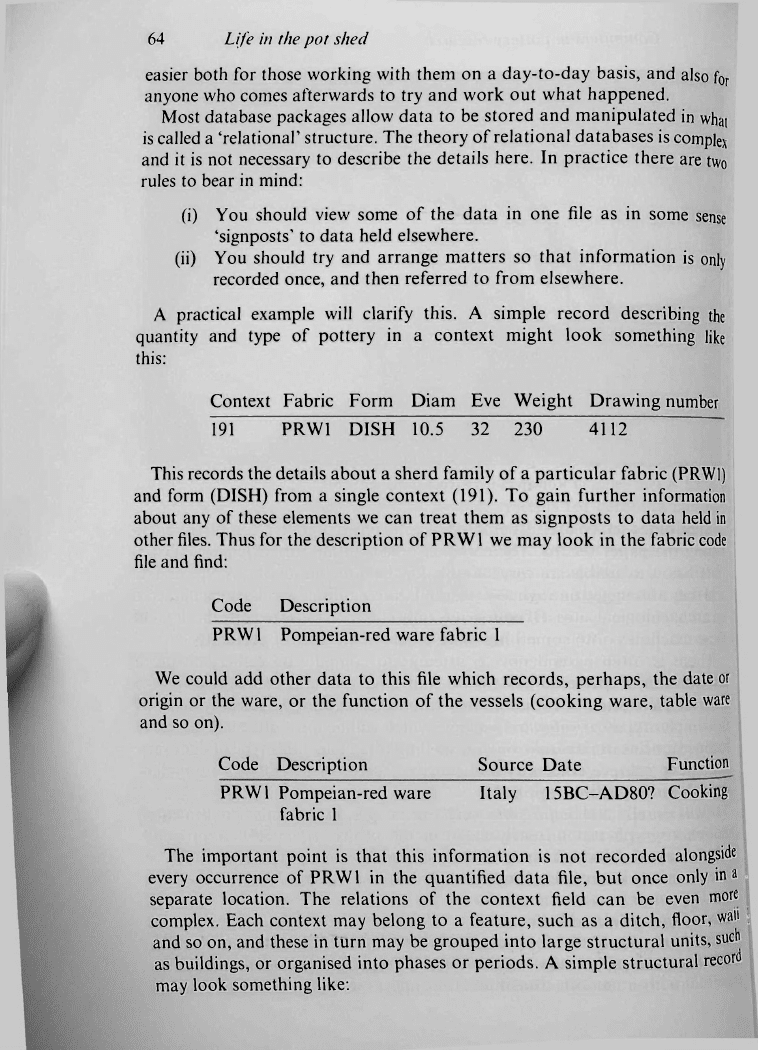
64 Life in the pot shed
easier both for those working with them on a day-to-day basis, and also fo
r
anyone who comes afterwards to try and work out what happened.
Most database packages allow data to be stored and manipulated in
what
is called a 'relational' structure. The theory of relational databases is complex
and it is not necessary to describe the details here. In practice there are
two
rules to bear in mind:
(i) You should view some of the data in one file as in some
sense
'signposts' to data held elsewhere.
(ii) You should try and arrange matters so that information is only
recorded once, and then referred to from elsewhere.
A practical example will clarify this. A simple record describing the
quantity and type of pottery in a context might look something like
this:
Context Fabric Form Diam Eve Weight Drawing number
191 PRW1 DISH 10.5 32 230 4H2
This records the details about a sherd family of a particular fabric (PRWl)
and form (DISH) from a single context (191). To gain further information
about any of these elements we can treat them as signposts to data held in
other files. Thus for the description of PRWl we may look in the fabric code i
file and find:
Code Description
PRWl Pompeian-red ware fabric 1
We could add other data to this file which records, perhaps, the date or
origin or the ware, or the function of the vessels (cooking ware, table ware
and so on).
Code Description Source Date Function I
PRWl Pompeian-red ware Italy 15BC-AD80? Cooking
fabric 1
The important point is that this information is not recorded alongside
!
every occurrence of PRWl in the quantified data file, but once only in® 1
separate location. The relations of the context field can be even more
complex. Each context may belong to a feature, such as a ditch, floor, v«P I
and so on, and these in turn may be grouped into large structural units, sueh
as buildings, or organised into phases or periods. A simple structural record
may look something like:

To keep or not to keep
Context Feature
191 Pit 6
and this structural record may in turn relate to broader groups:
Feature Phase
Pit6 Ilia
Phase Date
Ilia AD50-70
The query languages built into most relational database systems are
designed to allow selections to take place by specifying criteria which span
from
one
file
to another. Thus it would be possible to select all contexts which
contain, for instance, cooking wares in Phase Ilia, by following the links
from one file to another and back to the main ceramic data file. The benefits
of such an arrangement are also clear when the time comes to make changes
to the data. If Phase Ilia is no longer considered to be AD 50-70 but AD
70-100, then only one change is necessary rather than many hundreds or even
thousands - all cross-references are automatically up-dated. Similarly the
movement of groups of contexts from one phase to another, which invariably
happens many times during the record-preparation process, is accomplished
by adjusting only one or two links.
Finally, it is important to maintain adequate documentation on the pro-
cedures that you have used in creating and maintaining any database (and
indeed any other type of recording system). This should routinely include all
expansions of all keywords or codes used and explanations of the relation-
ships between the records and files. Using an undocumented computer system
is akin to keeping your records on the backs of old envelopes, and many of
the long-term hopes of building up reusable archives of data will never be
realised.
To keep or not to keep
Sooner or later you will face the problem of establishing or operating a
retention policy. If you work as part of a museum or large excavation unit
then it should already exist but if not you may have to consider some
difficult
problems. Museums have always existed to manage collections, whatever
their other objectives. It is therefore contrary to normal museum practice to
discard material; yet it is neither possible nor desirable to collect material
regardless of its potential information content. In some parts of the world.
North Africa or the Middle East for example, the quantity of pottery
produced through excavation may be too great to consider the total retention
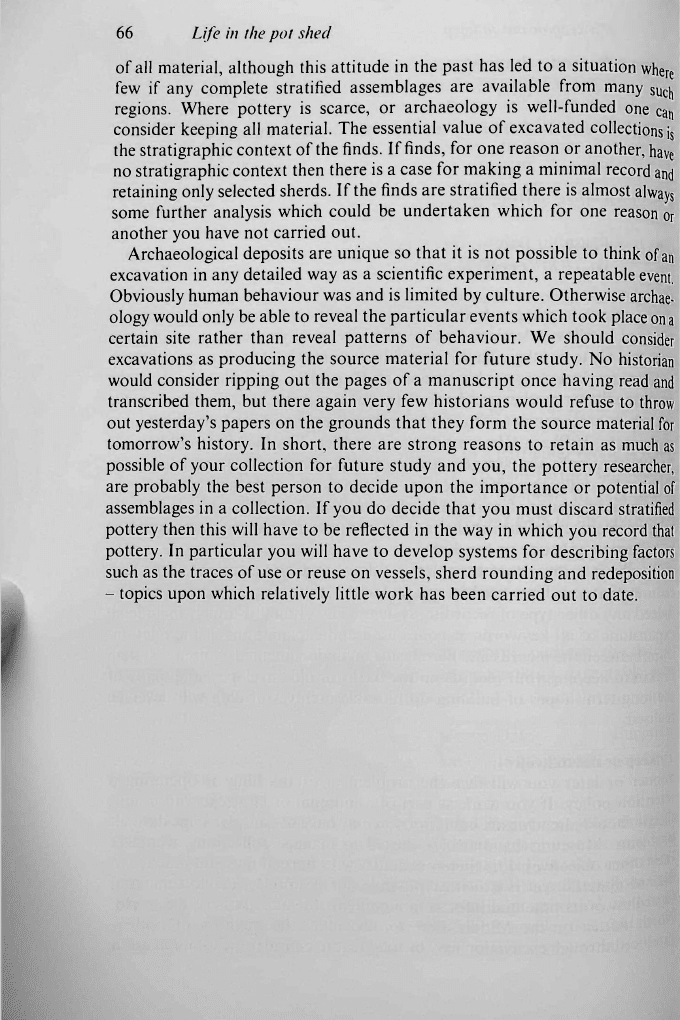
66 Life in the pot shed
of all material, although this attitude in the past has led to a situation where
few if any complete stratified assemblages are available from many such
regions. Where pottery is scarce, or archaeology is well-funded one can
consider keeping all material. The essential value of excavated collections i
s
the stratigraphic context of the finds. If finds, for one reason or another,
have
no stratigraphic context then there is a case for making a minimal record
and
retaining only selected sherds. If the finds are stratified there is almost always
some further analysis which could be undertaken which for one reason or
another you have not carried out.
Archaeological deposits are unique so that it is not possible to think of an
excavation in any detailed way as a scientific experiment, a repeatable event.
Obviously human behaviour was and is limited by culture. Otherwise archae-
ology would only be able to reveal the particular events which took place
on a
certain site rather than reveal patterns of behaviour. We should consider
excavations as producing the source material for future study. No historian
would consider ripping out the pages of a manuscript once having read and
transcribed them, but there again very few historians would refuse to throw
out yesterday's papers on the grounds that they form the source material
for
tomorrow's history. In short, there are strong reasons to retain as much as
possible of your collection for future study and you, the pottery researcher,
are probably the best person to decide upon the importance or potential of
assemblages in a collection. If you do decide that you must discard stratified
pottery then this will have to be reflected in the way in which you record that
pottery. In particular you will have to develop systems for describing factors
such as the traces of use or reuse on vessels, sherd rounding and redeposition
- topics upon which relatively little work has been carried out to date.
